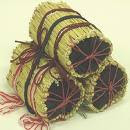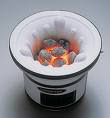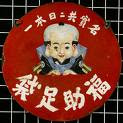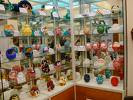[ . BACK to DARUMA MUSEUM TOP . ]
sumi 炭 charcoal
sumi 墨 Chinese ink for writing with the brush
:::::::::::::::::::::::::::::::::::::::::::::::::::::::::::::::::::::::::::::::::::::::::::::::::::::
for kigo, see below
Black Daruma 黒字の炭だるま
made with coal coating
 白河のだるまの意匠は松平定信公お抱えの絵師・谷文晁(たにぶんちょう)が考案したものと伝えられ、マユは鶴が飛ぶ姿に、ヒゲは亀に、ビンやアゴヒゲは松竹梅に見立てています。かつては目を入れて売られていましたが、今は願い事が叶うと瞳を入れる「だるま」になりました。
source : ysp.gr.jp
sumi Daruma 炭だるま charcoal Daruma
白河のだるまの意匠は松平定信公お抱えの絵師・谷文晁(たにぶんちょう)が考案したものと伝えられ、マユは鶴が飛ぶ姿に、ヒゲは亀に、ビンやアゴヒゲは松竹梅に見立てています。かつては目を入れて売られていましたが、今は願い事が叶うと瞳を入れる「だるま」になりました。
source : ysp.gr.jp
sumi Daruma 炭だるま charcoal Daruma
Made with the wish for writing black figures in your business.
A Daruma Doll in a traditional way, made of paper, but the final cover is a coating of charcoal (eco-powder) which is supposed to do the following things:
Minimize evil influnence of magnetic waves
Keeps things fresh
Effect of infrared wavelength
Effect of fresh wood air
Regulates heat
Odoeater

. . . . .
. Charcoal Daruma from Nagano .
:::::::::::::::::::::::::::::::::::::::::::::::::::::::::::::::::::::::::::::::::::::::::::::::::::::
sumishi 墨師 making charcoal for writing
 source : edoichiba.jp/. sumisi...
. sumiyaki 炭焼 (すみやき) making charcoal .
source : edoichiba.jp/. sumisi...
. sumiyaki 炭焼 (すみやき) making charcoal .
:::::::::::::::::::::::::::::::::::::::::::::::::::::::::::::::::::::::::::::::::::::::::::::::::::::
ALL WINTER KIGO : COALS
sumi 炭 (すみ) charcoal
Holzkohle
mokutan 木炭(もくたん)charcoal
katazumi 堅炭(かたずみ)hard charcoal
shirozumi 白炭(しろずみ)white charcoal
often used in a decorative way for the tea ceremony
. . . CLICK here for Photos !
yokoyamazumi 横山炭(よこやまずみ)a kind of white charcoal
binchoo 備長(びんちょう)special charcoal from Wakayama
.....
binchootan 備長炭 binchotan charcoal from Wakayama
(see below)
 hanazumi
hanazumi 花炭(はなずみ)flowers prepared as charcoal
suminaya 炭納屋(すみなや)shed for charcoal
sumi hiku 炭挽く(すみひく)sawing charcoal
konasumi 粉炭(こなずみ)fine coal, powder coal
sumikuzu 炭屑(すみくず)scraps of charcoal
sumi no ka 炭の香(すみのか)smell/fragrance of charcoal
Sakurazumi 佐倉炭(さくらずみ)charcoal from Sakura
Onozumi 小野炭(おのずみ)
charcoal from the Ono area in Kyoto
This region was famous for its white coal for the tea ceremony.
消炭に薪割る音かをのの奥
keshizumi / keshi-zumi ni maki waru oto ka Ono no oku
小野炭や手習ふ人の灰ぜせり
Ono-zumi ya tenarau hito no hai zeseri
白炭やかの浦島が老の箱
shirozumi ya ka no Urashima ga oi no hako
MORE - poems about charcoal by
. Matsuo Basho 松尾芭蕉 - Archives of the WKD .
. Ono no Komachi 小野 小町 .
The famous beauty.
.................................................................................
sumiuri, sumi-uri 炭売(すみうり)charcoal vendor, charcoal seller

They sold charcoal in small amounts to the poor people of Edo.
炭売りに鏡みせたる女かな
sumiuri ni kagami misetaru onna kana
to the charcoal vendor
this woman shows
a mirror . . . . .
The cut marker KANA is at the end of line 3.
炭売に日のくれかゝる師走かな
sumiuri ni hi no kurekakaru shiwasu kana
(1771)
for the charcoal vendor
the sun is about to set
on the last day of the year . . .
The cut marker KANA is at the end of line 3.
蕪村こがらしや炭売ひとりわたし舟
kogarashi ya sumiuri hitori watashibune
withering wind -
only one charcoal seller
on the ferry boat
. Yosa Buson 与謝蕪村 in Edo .
- - - - -
炭売りの人をぬくめて身は寒し
sumi uri no hito o nukumete mi wa samushi
the charcoal vendor
makes other people warm -
his own body cold
anonymous from the Edo period
.................................................................................
sumibi 炭火 (すみび)
charcoal fire
sumigashira 炭頭(すみがしら)smoldering charcoal
..... iburizumi 、燻り炭(いぶりずみ)
hanezumi 跳炭(はねずみ)scattering charcoal
..... hashirizumi 走炭(はしりずみ)
joo 尉(じょう)white ashes (from charcoal fire)
..... okorizumi おこり炭(おこりずみ)
uzumibi 埋火 (うずみび) "hidden fire"
..... ikebi いけ火(いけび), ikezumiいけ炭(いけずみ)
Some charcoal is left under the ashes to smolder and provide a bit of warmth.
keshizumi 消炭 (けしずみ) extinguishing the fire
..... keshizumi 消え炭(きえずみ), ukizumi 浮炭(うきずみ), keshioki消燠(けしおき),
hikeshitsubo 火消壺(ひけしつぼ) pot to extinguish a fire
. . . CLICK here for Photos !
Gefäß, das über ein Holzkohlefeuer gestülpt wird, um es zu löschen.
 fukube, looks like Daruma san
sumitori
fukube, looks like Daruma san
sumitori 炭斗 (すみとり) basket to carry charcoals
..... sumitori 炭取(すみとり)
. . . CLICK here for sumitori Photos !
sumikago 炭籠(すみかご), sumibitsu炭櫃(すびつ)
sumihisago (hisago) 炭瓢(すみひさご)
sumifukube 炭ふくべ(すみふくべ)coal carrier in the form of a gourd
ubu 烏府(うふ)ubu coal carrier
. . . CLICK here for ubu Photos !
juunoo 十能(じゅうのう)metal ladle for carrying coals
. . . CLICK here for Photos !
sumibako 炭箱(すみばこ) box with charcoals
 sumidawara
sumidawara 炭俵 (すみだわら) sack for wrapping charcoal
..... sumigamasu 炭叺(すみがます), sumisugo 炭すご(すみすご), datsu だつ
sack for charcoal
tadon 炭団 (たどん/ tandon たんどん )
charcoal briquette
tadon hooshi 炭団法師(たどんほうし) producer of briquettes
tadondama 炭団玉(たどんだま)round briquette
tadon hosu 炭団干す(たどんほす)to dry briquettes
. . . CLICK here for Photos !
Brickett
sekitan 石炭 (せきたん) coal, hard coal
..... tan たん、ishizumi いしずみ
. . . CLICK here for Photos !
goheita 五平太(ごへいた)Kyushu dialect. Named after one Koheita, who first dug it out of the ground in Kita Kyushu.
iwaki 岩木(いわき)"cliff stone" type of coal
rentan 煉炭 (れんたん) small charcoal briquet, briquette
rentan hibachi 煉炭火鉢(れんたんひばち)brazier for small briquettes
 mametan
mametan 豆炭(まめたん)"small briquette" like an egg
Often used for the small burners for grilling fish and vegetables.
. . . CLICK here for Photos !
Eierbrikett
. Hibachi, Braziers 火鉢 . Japan
. Jiko (brazier) and makaa (charcoal) . Kenya
.................................................................................
. sumiyaki 炭焼 (すみやき) making charcoal
a KIGO list
. sumigama 炭竈 charcoal kilns .
- and their legends
:::::::::::::::::::::::::::::::::::::::::::::::::::::::::::::::::::::::::::::::::::::::::::::::::::::
 Binchō-tan or white charcoal
Binchō-tan or white charcoal
or binchō-zumi (備長炭) is a traditional charcoal of Japan. It dates to the Edo period, when during the Genroku era, a craftsman named
Bitchū-ya Chōzaemon (備中屋 長左衛門) began to produce it in Tanabe, Wakayama. The raw material is oak, specifically
ubame oak (Quercus phillyraeoides), now the official tree of Wakayama Prefecture. Wakayama continues to be a major producer of high-quality charcoal, with the town of Minabe, Wakayama producing more binchō-tan than any other town in Japan.
The fineness and high quality of binchō-tan are attributed to steaming at high temperatures. Although it is often thought that binchō-tan burns hot, it actually burns at a lower temperature than ordinary charcoal but for a longer period of time. Because it does not release smoke or other unpleasant flavors, it is a favorite of
unagi and yakitori cooks. Due to difficulties in identifying the producing region, the name binchō-tan has come into broader use to designate white charcoal generally, and even products from outside Japan, as well as those made of other species, have come to use the name. The amount of binchō-tan sold domestically in Japan markedly decreased following a 2004 export restriction promulgated for forest protection by the People's Republic of China.
To differentiate the aforementioned "non-pure" products, there is a movement to call binchō-tan produced in Wakayama
Kishū binchō-tan.
Binchō-tan has found uses other than as a fuel. Because it has numerous small pores, it can absorb chemical substances. Bits can be added to rice during cooking to remove chalky flavor, placed in shoe-cabinets to absorb odors, and put in rooms to freshen the air. There are many more supposed benefits and health values of white charcoal. Currently there are a number of binchō-tan-based consumer products on the market such as socks, shirts, shampoo, cosmetic products, and many more.
Binchō-tan or white charcoal is harder than black charcoal, and rings with a metallic sound when struck. Wind chimes and a musical instrument, the
tankin ("charcoal-xylophone") have been made from it.
© More in the WIKIPEDIA !
Reference : Binchotan
備長炭枕すがしき虫の秋
binchootan makura sugashiki mushi no aki
my pillow of charcoal
just so refreshing -
autumn of the insects
(tr. Gabi Greve)
Yooko 葉子
Insects and Kigo
尉厚く被てゐて春の備長炭
joo atsuku kisete iru haru no binchootan
the white ashes
cover it thickly -
bincho coals in spring
Fuke Toshiko ふけとしこ (鎌の刃)
Tr. Gabi Greve
:::::::::::::::::::::::::::::::::::::::::::::::::::::::::::::::::::::::::::::::::::::::::::::::::::::

Black Daruma with Child
:::::::::::::::::::::::::::::::::::::::::::::::::::::::::::::::::::::::::::::::::::::::::::::::::::
. WASHOKU
Yakiniku, beef grilled on binchotan charcoal
sumidawara amu 炭俵編む(すみだわらあむ)
making straw bags for charcoal
kigo for late autumn
Ash, ashes (hai) and related kigo
Check the WKD LIST of
. HUMANITY and Winter Kigo
:::::::::::::::::::::::::::::::::::::::::::::::::::::::::::::::::::::::::::::::::::::::::::::::::::::
More kigo with black KURO
. kurogeta 黒北風 (くろぎた, kurogita) north wind in spring
. kuro mebaru 黒めばる(くろめばる)black rock fish
all spring
. kuro suzumebachi 黒雀蜂(くろすずめばち)
black hornet
all spring
. kurohae, kuro-hae 黒南風 (くろはえ)
"black southern wind"
mid-summer
. kurogoma 黒胡麻(くろごま)black sesame
mid-autumn
 . Kokutei 黒帝 Black Emperor
. Kokutei 黒帝 Black Emperor
deity of black and winter
:::::::::::::::::::::::::::::::::::::::::::::::::::::::::::::::::::::::::::::::::::::::::::::::::::::
WORLDWIDE
Ireland
"black ice"
which is the very dangerous condition of the roads, arising when it rains on a still-frozen surface.
The ice is not, of course, black, but transparent -- it is the black of the road surface that makes the ice invisible and causes many accidents.
Isabelle Prondzynski
.................................................................................
USA
black friday
the day following Thanksgiving Day in the United States, traditionally the beginning of the Christmas shopping season.
On this day, many retailers open very early, often at 4 a.m., or earlier, and offer promotional sales to kick off the shopping season, similar to Boxing Day sales in many commonwealth countries. Black Friday is not actually a holiday, but many employers give their employees the day off, increasing the number of potential shoppers. It has routinely been the busiest shopping day of the year since 2005 . . .
© More in the WIKIPEDIA !
::::::::::::::::::::::::::::::::::::::::::::::::::::::::::::::::::::::::::::::::::::::::::::::::::::::::::::::::::::::::::::::::::::
sumi ningyoo 炭人形 dolls made from charcoal

from Tozawa village 戸沢村, Yamagata
Yaguchi dolls 矢口人形
Made from powder of paulownia coal.
A pun on words with the owl, fukuro
すみ福ろう(不苦労) fu kuroo - know no hardship
source : yamagata-np.jp
. Suwa no Sumi Daruma 諏訪の炭だるま .
from Suwa town, Nagano
. sumi ningyoo 墨人形 / 人形墨 dolls from Sumi writing ink .
sumi 墨 Chinese ink for writing with the brush
. Regional Folk Toys from Japan .
:::::::::::::::::::::::::::::::::::::::::::::::::::::::::::::::::::::::::::::::::::::::::::::::::::::
. Black Dragon 黒龍 Kokuryu .
. Black Buddha Statues 黒仏 kurobotoke .
. Daruma Museum . TOP
[ . BACK to WORLDKIGO TOP . ]
- #sumi #charcoal -
:::::::::::::::::::::::::::::::::::::::::::::::::::::::::::::::::::::::::::::::::::::::::::::::::::::




























































